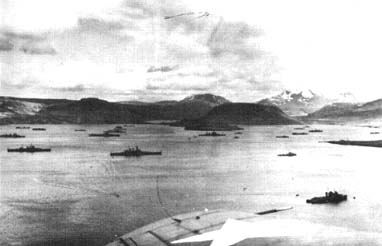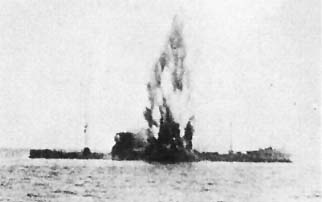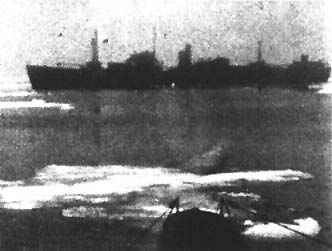The Convoy Battles
PQ-17
The greatest Convoy disaster
The Russia convoys
When the Wehrmacht smashed into the Soviet Union in June 1941 Russia and Britain found themselves in alliance against Germany. As a result Britain agreed to supply the Soviet Union with material and goods via convoys through the Arctic Ocean (the greatest support of course came from the United States though).
The destinations were the northern ports of Murmansk and Arkhangelsk. To reach them, the convoys had to travel dangerously near the German occupied Norwegian coastline.
Convoys headed for Russia were known as PQ convoys and those heading back from Russia were designated as QP convoys (interestingly the officer in charge of planning these earliest Russia convoys was Commander P.Q. Edwards and they were soon nicknamed after his initials).
The first convoy left Britain in August 1941 and by the spring of 1942 only one ship of the 103 that had been sent had been lost and 12 convoys had passed through those waters. That ship had been lost as the new year of 1942 began and had fallen victim to one of the first U-boats sent into the Arctic. That gave the allied a grim warning that things would not be that quiet much longer.
The first military loss from these convoys happened to PQ-8 when U-454 (Kptlt. Hackländer) sank the British destroyer HMS Matabele with almost all hands north-east of the Kola peninsula on 17 Jan, 1942.
From May 24 right until May 30, 1942 German aircraft made 245 bomber and torpedo sorties against convoy PQ-16, the largest Russia convoy so far with 30 ships, sinking 5 ships and damaging 4. This was the biggest blow any convoy had suffered in the Arctic.

PQ-17 leaving Hvalfjordur, Iceland
PQ-17 disembarks from Iceland
At 1600hrs on June 27, 1942 the ships of convoy PQ-17 left the berth in Hvalfjordur, Iceland and headed northwards. The convoy consisted of 35 ships and was heavily loaded with 297 aircraft, 594 tanks, 4246 lorries and gun carriers and additional 156,000 tons of cargo. This was enough to equip an army of 50,000 men and valued at 700 million dollars at the time.
The convoy was heavily escorted (although not as strong as the numbers suggested) including 4 cruisers, 3 destroyers and two British submarines and two tankers which would fuel the ships when needed.
Shortly after leaving Iceland one of the ships, SS Richard Bland, ran aground in Iceland and had to return and on June 29 the ships ran into heavy ice and 4 ships were heavily damaged and one, SS Exford was permitted to return to port. This left 33 ships en route to Russia.

Hoosier torpedoed by U-376
The Losses
All in all 24 ships were sunk out of the 33 which made up the convoy. 153 merchant men lost their lives, of those only 7 had perished before the convoy was scattered. The loss of material was extremely heavy; 22 merchant ships had been lost with a total of 142,518 tons of shipping and with them 3,350 motor vehicles, 430 tanks, 210 bombers and 99,316 tons of general cargo including radar sets and ammunition to name a few.
Additionally the Soviet tanker Azerbaijan had lost her cargo of linseed oil and much of Winston-Salem's cargo had also been jettisoned in Novaya Zemlya.
Ships lost from the convoy
| Date | Ship | Weight | Country | Sunk by |
| 4 July | Christopher Newport | 7,191 | US | U-457 |
| 4 July | William Hopper | 7,177 | US | U-334 |
| 2215hrs: Convoy is ordered to scatter and the escorts leave her | ||||
| 5 July | Navarino | 4,841 | UK | Luftwaffe |
| 5 July | Carlton | 5,127 | US | U-88 |
| 5 July | Fairfield City | 5,686 | US | Luftwaffe |
| 5 July | Daniel Morgan | 7,177 | US | U-88 |
| 5 July | Empire Byron | 6,645 | UK | U-703 |
| 5 July | River Afton | 5,423 | UK | U-703 |
| 5 July | Earlston | 7,494 | UK | U-334 |
| 5 July | Honomu | 6,977 | US | U-456 |
| 5 July | Peter Kerr | 6,476 | US | Luftwaffe |
| 5 July | Washington | 5,564 | US | Luftwaffe |
| 5 July | Bolton Castle | 5,203 | UK | Luftwaffe |
| 5 July | Zaafaran | 1,559 | UK | Luftwaffe |
| 6 July | Pan Atlantic | 5,411 | US | Luftwaffe |
| 6 July | John Witherspoon | 7,180 | US | U-255 |
| 7 July | Alcoa Ranger | 5,116 | US | U-255 |
| 7 July 0600 | Pankraft | 5,644 | US | Luftwaffe |
| 7 July 1600 | Aldersdale | 8,402 | US | U-457 |
| 7 July 2000 | Hartlebury | 5,082 | UK | U-355 |
| 8 July | Olopana | 6,069 | US | U-255 |
| 10 July | El Capitan | 5,255 | Panama | U-251 |
| 10 July | Hoosier | 5,060 | US | U-376 |
| 13 July* | Paulus Potter | 7,168 | Dutch | U-255 |

Paulus Potter drifting abandoned on July 13.
* Found afloat and deserted 8 days after being bombed by the Luftwaffe. 3 men from the U-boat boarded her and examined her to see if she could be sailed to Norway but found that impossible and Kptlt. Reche put a torpedo into it.
3 more losses took place when 3 of the 11 surviving ships from PQ-17; Silver Sword (sunk by U-255 on 20 July, 1942 for her 5th victim from the PQ-17), Bellingham and Gray Ranger were sunk on the return voyage from Russia in the next home bound convoy.
Luftwaffe flew 202 sorties against the convoy and lost 5 planes for the 8 ships they sank.
The next convoy to Russia
PQ-18 left Loch Ewe, Britain on 2 Sept, 1942 with 40 ships and arrived in Arkhangelsk on 17 Sept with 27 ships. U-boats had sunk 3 ships and Luftwaffe 10, but not without loss as 3 U-boats were lost U-88, U-457 and U-589 (there were no survivors from any of the U-boats).
Convoy operations to Russia were suspended after PQ-18 disaster and not resumed until JW-51 sailed in December 1942. The strategic effect of this battle was thus far greater than the materials and lives lost, it deprived Russia of several more convoys during the months immediately following PQ-17 and PQ-18.

